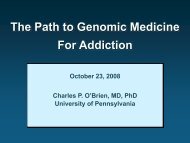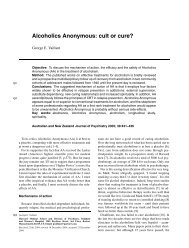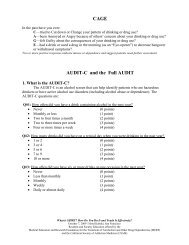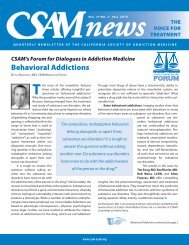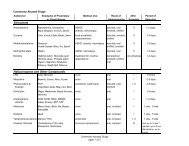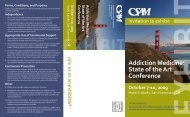SAN FRANCISCOMEDICINE - California Society of Addiction ...
SAN FRANCISCOMEDICINE - California Society of Addiction ...
SAN FRANCISCOMEDICINE - California Society of Addiction ...
You also want an ePaper? Increase the reach of your titles
YUMPU automatically turns print PDFs into web optimized ePapers that Google loves.
Starving System<br />
After guaranteed funding for the program sunsetted in 2006, the legislature has<br />
set annual funding levels—first increasing, then slashing them.<br />
2001/2002–<br />
2005/2006<br />
$120 million per year, as guaranteed by statute<br />
2006/2007 $145 million ($120 million in the Prop 36 trust fund and $25 million in new<br />
Offender Treatment Program, a program for Prop 36 participants)<br />
2007/2008 $120 million ($100 million in Prop 36 fund; $20 million in OTP)<br />
2008/2009 $108 million ($90 million in Prop 36 trust fund; $18 million in OTP)<br />
2009/2010 $63 million ($0 in Prop 36 fund; $18 million for OTP from General Fund and<br />
$45 million in OTP from federal stimulus funds to OTP)<br />
2010/2011 The Governor has proposed $0 for both Prop 36 and OTP.<br />
Source: <strong>California</strong> Department <strong>of</strong> Finance<br />
Continued from the previous page . . .<br />
the mainstream health care and insurance<br />
systems—may finally be allowed to come<br />
in from the cold.<br />
The <strong>California</strong> Legislature has already<br />
formally acknowledged that drug<br />
use is a health issue, having passed parity<br />
legislation (vetoed by the governor). Similarly,<br />
the <strong>California</strong> electorate is on record<br />
as supporting expanded access to treatment—and<br />
reduced incarceration—for<br />
both alcohol and drugs problems (Prop<br />
36 in 2000) and mental health issues<br />
(Prop 63 in 2004).<br />
On the public and personal levels,<br />
<strong>California</strong>ns understand that drug use is<br />
fundamentally a health matter. And yet<br />
our criminal code continues to require arrest,<br />
prosecution, and punishment. More<br />
than 270,000 people were arrested for a<br />
drug <strong>of</strong>fense in <strong>California</strong> in 2008 (more<br />
than 78,500 for marijuana), accounting<br />
for one-quarter <strong>of</strong> all felony arrests in<br />
the state that year. 9 About 30,000 people<br />
were in prison for a nonviolent drug<br />
<strong>of</strong>fense that year; 10 they made up more<br />
than 15% <strong>of</strong> the prison population and<br />
cost $1.5 billion per year to incarcerate<br />
(or $49,000 each 11 ). A shocking 28.4%<br />
<strong>of</strong> new felony admissions to prison and<br />
32.7% <strong>of</strong> parolees returning to prison<br />
with a new term were for drug <strong>of</strong>fenses<br />
in 2008. 12 This does not include drugrelated<br />
technical parole revocations. The<br />
vast majority <strong>of</strong> these commitments are<br />
for drug possession, not sale, manufacture,<br />
or transport.<br />
Most European countries and Canada<br />
have long ago embraced a public health<br />
posture about drug use and simple possession.<br />
The combination <strong>of</strong> a <strong>California</strong><br />
budget disaster and the manifest failure <strong>of</strong><br />
three decades <strong>of</strong> the war on drugs may yet<br />
turn out to be a crisis too good to waste.<br />
We can think afresh about addictions and<br />
their treatment in the context <strong>of</strong> health<br />
care reform.<br />
Margaret Dooley-Sammuli is deputy<br />
state director in Southern <strong>California</strong> for<br />
the Drug Policy Alliance, the nation’s leading<br />
organization working to end the war<br />
on drugs and a proponent <strong>of</strong> Proposition<br />
36 in 2000.<br />
Peter Banys, MD, is health sciences<br />
clinical pr<strong>of</strong>essor <strong>of</strong> psychiatry at UCSF.<br />
Since its passage, Proposition<br />
36 has<br />
• Provided treatment to 30,000+<br />
people a year. Almost 300,000 people<br />
have entered community-based treatment<br />
under Prop 36, half <strong>of</strong> whom had<br />
never received treatment before. About<br />
one-third <strong>of</strong> participants complete<br />
treatment and probation; about half<br />
stay for at least 90 days, “the minimum<br />
threshold for beneficial treatment.” 13<br />
• Sharply reduced the number<br />
<strong>of</strong> people in state prison for simple<br />
drug possession. In the twelve years<br />
prior to Prop 36, the number <strong>of</strong> people<br />
in state prison for drug possession<br />
quadrupled, peaking at 20,116 in June<br />
2000. That number dropped by onethird<br />
shortly after Prop 36 took effect<br />
and remained lower by 8,000 (40%)<br />
as <strong>of</strong> December 2008. 14<br />
• Reduced state costs by more<br />
than $2 billion. For every $1 invested<br />
in Prop 36, the state saves a net $2.50–<br />
4.00 15 Average per-person treatment<br />
costs are about $3,300 per year, while<br />
incarceration costs $49,000 per year.<br />
UCLA calculated that the program cut<br />
costs by $173 million its first year;<br />
the Legislative Analyst’s Office calculated<br />
annual savings for later years at<br />
$200–300 million.<br />
• Achieved expected rates <strong>of</strong><br />
“progress” and “completion.” According<br />
to UCLA, Prop 36 completion<br />
rates are “fairly typical” <strong>of</strong> drug users<br />
referred to treatment by the criminal<br />
justice system. 16 The statewide<br />
completion rate reached 40% in 2007.<br />
At the county level, Prop 36 completion<br />
rates range from 26% to more<br />
than 50%.<br />
He is the director <strong>of</strong> the Substance Abuse<br />
Programs and the Substance Abuse Physician<br />
Fellowship Program at the V.A.<br />
Medical Center, San Francisco. He is past<br />
president <strong>of</strong> the <strong>California</strong> <strong>Society</strong> <strong>of</strong> <strong>Addiction</strong><br />
Medicine.<br />
A full list <strong>of</strong> references is available<br />
online at www.sfms.org.<br />
30 San Francisco Medicine June 2010 www.sfms.org




